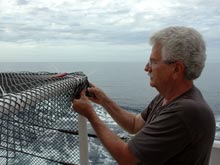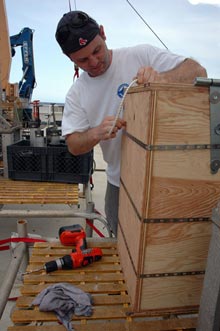During the transit to Atwater Valley 340, benthic ecologist Bob Carney puts the finishing touches on a fish trap. Click image for larger view and image credit.
Erik Cordes fashions a plywood box to house a suite of 16 push cores on the elevator. The box must be designed to be easily opened and closed with the remotely operated vehicle Jason's manipulator arm. It also must be strong enough to protect the cores as they’re brought up through the splash zone. Click image for larger view and image credit.
A Ship Full of MacGyvers
June 7, 2007
Jeremy Potter
NOAA Office of Ocean Exploration
27° 38.94 N
88° 22.11 W
Part Indiana Jones part Sherlock Holmes. . . . .That’s how people described MacGyver, the main character in the hit TV show that aired from 1985 until 1992. He was a different kind of hero: a natural genius whose scientific prowess, creativity, and quick wits allowed him to perform incredible feats with basic everyday objects. It seemed MacGyver could fix just about anything with duct tape and a few paperclips.
After being onboard the NOAA research vessel (R/V) Ronald H. Brown for just a few days, I feel like I’m surrounded by a ship full of MacGyvers. The resourcefulness of the R/V Brown crew, the Jason remotely operated vehicle group, and the science party continuously impresses me.
Despite all of the incredible technologies available for science, advanced tools typically need to be tested, refined, and tested again before they can be incredibly reliable. Even when you’ve got them up and running, complex technologies with lots of moving parts and wiring are more apt to break down, especially when you add salt water and a moving platform into the mix. For ease of use and reliability alone, simple low-tech approaches are the solutions preferred by many scientists and mariners who face big problems at sea.
During the two-day transit to our first dive site at Atwater Valley 340, I’ve seen plywood, caulk, a drill, a ratchet, zip-ties, various colors of electrical tape, and a bunch of nuts, bolts, and washers used in a variety of ways to simply and elegantly solve numerous problems. The combination of low tech and high tech tools should prove quite adept at tackling most of the science party’s sampling requirements.
It’s quite impressive to see the creative minds of scientists and engineers working together towards a common goal. . . . It's something that I think would make MacGyver quite proud.

































